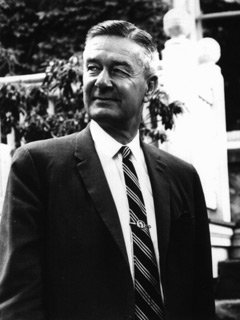John W. Nason
1940–1953

A Rhodes Scholar from Minnesota, John W. Nason (1905–2001) taught philosophy at Swarthmore during the 1930s before being appointed president at age 35. In addition to guiding Swarthmore during the difficult years of World War II and the rapid expansion of higher education in the late 1940s and early 1950s, he served on the committee that managed the program for conscientious objectors to the war.
Under his administration, the College cooperated with civil defense, Red Cross and first-aid training, and other nonmilitary support services in the war’s early years. It also moved to a year-round class schedule, which lasted for three years, to accelerate graduation for those who might be drafted. The College experienced further strain by the departure of a quarter of the faculty for war work.
Like Swain, Nason eventually accepted military troops on campus, including a Navy V-12 unit, which was interested in Swarthmore’s outstanding Engineering Department. In addition, 49 Chinese naval officers also came to campus for training and English language classes. Despite the Navy’s focus on the sciences, Swarthmore continued to push for a complete liberal arts education, recognizing the importance of well-educated people for a postwar society.
Nason’s contributions to higher education extended far beyond campus. As president of the National Japanese American Student Relocation Council, Nason helped liberate nearly 4,000 interned students from the War Relocation Authority’s camps and found places for them in 600 colleges and universities, including Swarthmore. He later referred to his efforts on behalf of Japanese-American students as the most important and satisfying of his life’s work. Swarthmore continued to show a commitment to intellectual freedom when Nason and the faculty formally expressed their support for “members of the University of California faculty who refused to sign the University’s loyalty oath,” calling it a “dangerous restraint on academic freedom.”
After the war, enrollment reached an all-time high of more than 1,000 students, and an additional dorm was purchased to respond to the overflow. Calls came from the student body to accept more students of color and more Jewish students. Ultimately, the Navy brought about the integration of the College’s student body with the enrollment of three black sailors. The size of the student body began to settle at about 1,000 while the number and quality of the applicants kept increasing, further establishing Swarthmore’s reputation for excellence.
After 13 years as Swarthmore’s president, Nason resigned to become president of the Foreign Policy Association. Under his leadership, the association served as a forum for public debate about foreign policy issues and resisted the attacks of Sen. Joseph R. McCarthy, who suspected any internationalist body of being sympathetic to communism. In addition, World Affairs Councils were established in many major American cities, and the public was encouraged to debate international issues under the association’s “Great Decisions” discussion programs. Nason later returned to Carleton College, his alma mater, and served as its fifth president for eight years, beginning in 1962.


